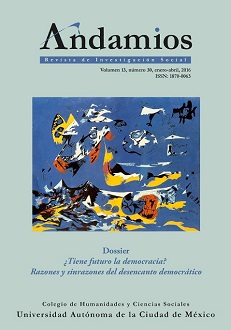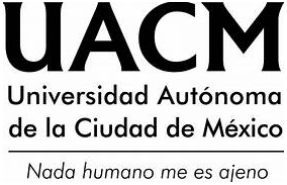Basis for a program of education of the emotions
DOI:
https://doi.org/10.29092/uacm.v13i30.4Keywords:
Emotional education, emotions, self-conscious reflection, narrative, community of inquiryAbstract
Contemporary research in psychology and neuroscience recognize the weight of emotions in the pursuit of our goals, in the development of our arguments and the quality of our social relationships. Philosophy and science no longer see reason as opposed to emotions; cooperation of emotions with cognition improves our practical rationality. Thus, the interest in the search for tools to educate our emotions becomes evident.
Based on psychological, neurological and philosophical research on emotions, this article presents, from the perspective of philosophy of education, certain crucial elements that allow for the implementation of emotional education: self-conscious reflection, narrative, and the methodology of community of enquiry, which includes the former elements.
Downloads
References
Apel, K. O. (1985), La transformación de la filosofía. I. Análisis del lenguaje, semiótica y hermenéutica. Madrid: Taurus.
____(2008), Semiótica filosófica. Buenos Aires: Prometeo.
Aristóteles (1993), Ética eudemia. Madrid: Gredos.
____(1999), Retórica. Madrid: Gredos.
Arnold, M. (1960), Emotion and personality. Nueva York: Columbia University Press.
Booth, W. (1988), The Company We Keep. An Ethics of Fiction. Oakland: University of California Press.
Brecht, B. (1992), Brecht on Theatre. The Development of an Aesthetic. Nueva York: Hill and Wang.
Carroll, N. (1996), “Film, Rhetoric and Ideology”, en N. Carroll (ed.),Theorizing the Moving Image. Nueva York: cup, pp. 275-289.
___(1998), A Philosophy of Mass Art. Oxford: Claredon Press.
Casacuberta, D. (2000), Qué es una emoción. Barcelona: Crítica.
Cortina, A. (2007), Ética de la razón cordial. Educar en la ciudadanía en el siglo XXI. Oviedo: Nobel.
Damasio, A. (2008), El error de Descartes. Barcelona: Crítica.
Descartes, R. (1965), “Tratado de las pasiones humanas”, Obras escogidas. Buenos Aires: Schafire, pp. 125-197.
Dixon, T. (2003), From Passions to Emotions. The Creation of a Secular Psychological Category. Nueva York: Cambridge University Press.
Dworkin, G. (1988), The Theory and Practice of Autonomy. Nueva York: Cambridge University Press.
Ekman, P. (1973), “Cross-Cultural Studies of Facial Expression”, en P.
Ekman (ed.), Darwin and Facial Expression. Nueva York: Academic Press, pp. 169-222.
Elster, J. (2002), Alquimias de la mente. La racionalidad y las emociones. Barcelona: Paidós.
Forst, R. (2014), Justification and Critique. Cambridge: Polity Press.
Frank, A. (2002), “Why study people’s stories? The dialogical ethics of narrative analysis”, International Journal of Qualitative Methods, 1 (1), pp. 1-20.
Frankfurt, H. (2006), La importancia de lo que nos preocupa. Buenos Aires: Katz.
Freire, P. (1975), Acción cultural para la libertad. Buenos Aires: Tierra Nueva.
____(1997), La educación como práctica de la libertad. México: Siglo xxi.
Frijda, N. (1996), “Passions: Emotion and socially consequential behavior”, en R.D. Kavanaugh, B. Zimmerberg y S. Fein (comps.), Emotions. Interdisciplinary Perspectives. Mahwah: Lawrence Erlbaum.
____(1988), “The laws of emotion”, American Psychologist, 43, pp. 349-358, trad. cast. “Las leyes de la emoción”, en M.D. Avia y M.L. Sánchez Bernardos (comps.) (1995), La personalidad. Aspectoscognitivos y sociales. Madrid: Pirámide.
Goleman, D. (2000), La inteligencia emocional. Buenos Aires: Vergara.
Habermas, J. (1989), Teoría de la acción comunicativa: complementos y estudios previos. Madrid: Cátedra.
Honneth, A. (1997), La lucha por el reconocimiento. Barcelona: Crítica.
James, W. (1884), “What is an Emotion?”, Mind, 9, 34, pp. 188-205.
Korsgaard, C. (2000), Las fuentes de la normatividad. México: Instituto de Investigaciones Filosóficas de la UNAM.
Lange, C. (1912), “The mechanism of the emotions”, en B. Rand (ed.), The Classical Psychologists. Boston: Houghton Mifflin, pp. 672-684, traducción de B. Rand tomada de C. G. Lange, Ueber Gemüthsbewegungen. Eine psycho-physiologische Studie, 1887, 3, (8).
Lazarus, R. (1991), Emotion and Adaptation. Nueva York: Oxford University Press.
Lipman, M. (2003), Thinking in Education. Cambridge: cup. (2001), Pensamiento complejo y educación. Madrid: Ediciones de la Torre.
____(1995), “Using Philosophy to Educate Emotions”, Analytic Teaching, 15, pp. 3-10.
Lipman, M., A. M. Sharp y F. Oscanyan (1980), Philosophy in the Classroom. Pensilvania: Temple University Press.
Lyons, W. (1993), Emotion. Cambridge: cup.
Marks, J. (1982), “A Theory of Emotion”, Philosophical Studies, 42, 2, pp. 227–242.
Mitmansgruber, H., T. Beck y G. Schubler (2008), “Mindful helpers: Experiential avoidance, meta-emotion, and well-being in paramedics”, Journal of Research in Personality, 42, pp. 1358–1363.
Neu, J. (2000), A Tear is an Intellectual Thing: The Meaning of Emotions. Nueva York: Oxford University Press.
Nussbaum, M. (1990), “Narrative Emotions: Beckett’s Genealogy of Love”, en M. Nussbaum, Love’s Knowledge: Essays on Philosophy and Literature. Nueva York: Oxford University Press, pp. 286-313.
____(1993), “Poetry and the Passions: Two Stoic Views”, en J. Brunschwig y M. Nussbaum (eds.), Passions and Perceptions. Cambridge: cup, pp. 97-149.
____(1997), Justicia poética. Barcelona: Andrés Bello.
____(2005), Upheavals of Thought. Cambridge: Cambridge University Press.
____(2010), Not for Profit. Why Democracy Needs the Humanities. Nueva Jersey: Princeton University Press.
Pardales, M. y M. Girod (2006), “Community of Inquiry: Its past and present future”, Educational Philosophy and Theory, vol. 38, núm. 3, pp. 299-309.
Peirce, C. S. (1955), The Philosophical Writings of Peirce. Nueva York: Dover.
Pereira, G. (2013), Elements of a Critical Theory of Justice. Basingstoke: Palgrave-Macmillan.
Ricoeur, P. (1996), Sí mismo como otro. Madrid: Siglo xxi.
Sharp, A. M. (2006), “La educación de las emociones en la comunidad de indagación”, Revista Internacional Magisterio, Bogotá, núm. 21, pp. 28-33.
Solomon, R. (2007), Ética emocional. Una teoría de los sentimientos. Barcelona: Paidós.
____(1993), The Passions: Emotions and the Meaning of Life. Indianapolis, Hackett Publishing Company.
Taylor, C. (1977), “What is Human Agency”, en M. Theodore, The Self. Psychological and Philosophical Issues. Oxford: Basil Balckwerll, pp. 103-135.
____(2005), “¿Cuál es el problema de la libertad negativa?”, en La libertad de los modernos, Buenos Aires: Amorrortu, pp. 257-281.
Weiner, B. (1986), An attributional theory of motivation and emotion. Nueva York: Springer.
Wells, A. y S. Cartwright-Hatton (2004), “Short form of the metacognitions questionnaire: Properties of the MCQ-30”, Behaviour Research and Therapy, 42, pp. 385–396.
Zajonc, R. (1980), “Feeling and thinking: Preferences need no inferences”, American Psychologist, 35, pp. 151–175.
Published
Issue
Section
License
This Journal is licensed under Creative Commons Mexico 2.5. It is allowed to reproduce and disseminate the contents of the Journal for educational or research purposes, not for profit, as long as they are not mutilated and cite the source (Andamios, Revista de Investigación Social) and the author.
The copyright of the articles published in Andamios, Revista de Investigación Social are transferred by the author(s) to Universidad Autónoma de la Ciudad de México when the originals have been accepted, so that they are published and distributed both in the printed and electronic versions of the Journal. However, as established by law, the author(s) retains their moral rights. The author(s) will receive a form of assignment of copyright that they must to sign when their original has been accepted. In the case of collective articles, the signature of one of the authors will suffice, provided that the latter has obtained the consent of the others.
Authors may use the material of their article in other works or books published by themselves, with the condition of quoting Andamios as the original source of the texts.
The articles contained in this publication are the responsibility of their authors and do not compromise the official position of Andamios, Revista de Investigación Social of the Universidad Autónoma de la Ciudad de México.


